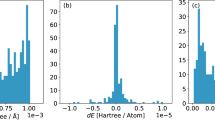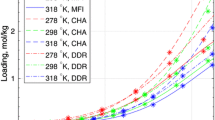Abstract
Structure and physisorption energy of alkanes in ZSM-22 are investigated using periodic density functional theory employing the new BEEF-vdW functional. Good agreement with experimental data is obtained, illustrating successful modeling of the van der Waals forces responsible for the adsorption. All calculations were performed on a single level of theory, and the method therefore provides an attractive possibility for an accurate theoretical description of the confinement effects observed in zeolite catalysis.
Graphical Abstract

Similar content being viewed by others
Avoid common mistakes on your manuscript.
1 Introduction
Zeolite acids are extensively used as heterogeneous catalysts in a wide variety of industrial processes [1, 2]. The success of zeolite catalysts is largely due to their size- and shape-selectivity [3], a property that originates from a porous structure of channels and cages inside the materials. Much like solvent effects prevalent in solution phase chemistry, stabilization of molecular species by van der Waals (vdW) interactions inside these nano spaces can influence selectivity and reactivity of catalytic reactions in zeolites [4]. Thus, when aiming for a greater understanding of zeolite acid chemistry through theoretical modeling, it is crucial that the model correctly describes the vdW interactions giving rise to the confinement effects. For systems of the size and complexity of zeolites, the method of choice in the vast majority of computational works is density functional theory (DFT). While commonly used density functionals can account well for the zeolite structure, they are inadequate in describing the long-range vdW interactions [5–7]. Different approaches to remedy this inadequacy have been taken [8–21]. In the DFT-D method of Grimme et al. [12–15], a dispersion energy calculated from damped atomic pair potentials is added to the DFT energy. This pragmatic approach has been applied in a number of computational studies of zeolite chemistry employing finite-size clusters [22–25] as well as periodic structures [26–29]. In studies of hydrocarbon reactivity in zeolites results of near chemical accuracy have been obtained using a hybrid MP2:DFT method [17, 19, 30]. However, high demands of computational resources somewhat limits the applicability of the latter method.
Recently, the BEEF-vdW functional was developed to simultaneously describe vdW interactions and chemical bond formation correctly [31]. That was achieved by basing the nonlocal correlation term of BEEF-vdW on the work of Lundqvist, Langreth and coworkers (vdW-DF2) [10, 32]. Using the algorithm of Román-Peréz and Soler [33] it is implemented for use in DFT calculations employing periodic boundary conditions (pbc) [31]. The latter property is valuable, since it has been shown by Tuma and Sauer [30] that methods employing pbc in general are preferable to the finite size cluster models of zeolites. Furthermore, a pbc DFT calculation not employing any parametrization to the zeolite system represents a conceptual simplification over multilevel methods where a finite cluster is embedded in a larger periodic structure.
This work presents results from pbc DFT calculations on a zeolite system using the BEEF-vdW functional to account for vdW interactions not only in energies, but also in relaxation of atomic positions. As a prime example of a case where vdW interactions dominate the physisorption of n-alkanes in ZSM-22 has been chosen. Experimental data are available for direct comparison [34, 35]. Adsorption of alkanes in zeolites has been the subject of a number of computational studies in recent years [36–44]. The few of these that employ pbc DFT indeed find that physisorption energies are poorly reproduced due to the inadequate description of the vdW interaction [36, 43, 44].
2 Computational Details
The self-consistent pbc DFT calculations employing the BEEF-vdW functional are performed using GPAW [45, 46], a real-space grid implementation of the projector augmented-wave method [47], interfaced with the ASE package [48]. Periodic boundary conditions were applied in all calculations, except for molecules in vacuum. Based on convergence tests, all calculations except the unit cell optimization employed a real-space grid spacing of 0.2 Å.
The lattice constants of the silicalite of ZSM-22 were determined by minimizing the energy of fully relaxed atomic structures with respect to the three parameters defining the ortho-rhombic unit cell. This optimization used a force threshold of 0.03 eV/Å and a real-space grid spacing of 0.16 Å. Based on convergence tests of the total energy, a 1 × 1× 4 Monkhorst–Pack [49] k-space grid was used to sample the Brillouin zone and a 0.1 eV Fermi smearing was applied.
Energy and geometry optimizations of molecules in vacuum employed super cells with 5.0 Å vacuum to the cell wall in all directions, implying convergence of interactions energies at the meV level. A force threshold of 0.01 eV/Å was used in the geometry optimizations.
Based on convergence tests of adsorption energies, the calculations that employed the super cell shown in Fig. 1 (right) only sampled the Γ point of the Brillouin zone. A force threshold of 0.03 eV/Å was used in geometry optimizations in which the positions of all atoms in the super cell were relaxed. The position of the Al/Si substitution and the proton in the H-ZSM-22 super cell was chosen according to previous work [50].
3 Results and Discussion
Table 1 shows the lattice constants calculated with the BEEF-vdW functional compared to the corresponding experimental values [51]. The values obtained using the RPBE functional [50] are shown for comparison.
The results show that BEEF-vdW performs significantly better than RPBE, but more importantly that BEEF-vdW does not suffer from the problem of predicting much too soft lattices as the vdW-DF and vdW-DF2 functionals do [52, 53].
In the calculations presented in the following a primitive cell was used. This cell has a well-defined relation to the unit cell (Fig. 1, left), which reduces the number of atoms included in the calculation without influencing computed adsorption energies [50].
The calculations of physisorption of C1–C10 n-alkanes employed a super cell constructed from four repetitions of the primitive cell along the unidirectional channel of the zeolite (Fig. 1, right), making sure that interaction between neighboring alkanes in the periodical model was avoided. Physisorption energies of n-alkanes on both H-ZSM-22 and the corresponding silicalite were calculated. The silicalite calculations employed the aforementioned super cell, while in the case of H-ZSM-22 a single Si atom in the super cell was substituted by an Al atom and a proton added to a neighboring oxygen atom to maintain neutrality.
The positions of all atoms of the isolated molecules, the zeolite/silicalite and the physisorption adducts in the super cells were relaxed to obtain minimized electronic energies from which the physisorption energies
were calculated. In a computational study on the physi-sorption of alkanes on a series of acidic zeolites DeMoor et al. [37] found the difference between the adsorption energies and enthalpies to be within 5 kJ/mol in the temperature range 100–800 K. Since the experimental data used to benchmark our calculations fall within that temperature range [34, 35], the approximation
is employed. The alkane physisorption enthalpies calculated this way are displayed in Fig. 2 together with corresponding experimentally determined values from the work of Denayer et al. [34]. The values obtained by Ocakoglu et al. [35] are virtually identical.
Also shown in the figure are the lines obtained by fitting the physisorption enthalpies to a linear dependence on the number of carbon atoms N
The parameters obtained this way are shown in Table 2 together with the corresponding parameters derived from the data of Ocakoglu et al. Firstly, we note that the linear dependence of the adsorption enthalpy found experimentally is reproduced by the calculations. More importantly, the slope of this linear dependence is reproduced exceedingly well, as it within the uncertainty limits is identical to the ones derived from the experiments. The slope is determined by the interaction between the alkanes and the channel walls of the catalyst, why it is the same for both the zeolite and the silicalite. This interaction depends on a subtle interplay between the relative shape and size of the adsorbate and the channel, in which a balance of repulsive and vdW forces determines the magnitude of the interaction [54]. The fact that the correct slope is obtained from the calculated values means that the BEEF-vdW functional describes this balance very well.
As reflected by the β parameter, the calculations predict too strong adsorption of the alkanes in H-ZSM-22 by about 15 kJ/mol. However, assuming the temperature dependence (including the contribution from zero point vibrational energy) of the enthalpy to be, on average, the 5 kJ/mol mentioned above, the discrepancy between the calculated and experimentally determined enthalpies is reduced appreciably. The interaction with the Brøndsted acid active site in H-ZSM-22 (one site per super cell, Si/Al=95) can be estimated by comparing the β parameters obtained from the zeolite and silicate calculations, respectively. Their difference is 4 kJ/mol, which compares very well to the β=2 and 3 kJ/mol, respectively, derived from the experimental values (Si/Al=30, the authors assumed that the adsorbate interacted with a single acid site [34, 35]), although the uncertainties on these parameters prevent a definite conclusion.
4 Conclusion
The BEEF-vdW calculations presented in this letter represent the first pbc DFT calculations accurately modeling the complex interplay between repulsion and vdW interactions determining the physisorption of n-alkanes in porous zeolites. It is stressed that this result is obtained by first principles in the sense that no parametrization to the particular system or even zeolites in general has been employed. Furthermore, optimization of lattice constants, geometries of molecules, zeolites and physisorption complexes as well as calculations of energies are all performed using the same method, requiring reasonable computational resources. This universality and conceptual simplicity provides high expectations for the general applicability of the method in modeling and understanding the confinement effects of reactions in zeolite catalysis that have been observed experimentally.
References
Yilmaz B, Trukhan N, Müller U (2012) Chin J Catal 33:3
Wang Z, Yu J, Xu R (2012) Chem Soc Rev 41:1729
Smit B, Maesen TLM (2008) Nature 451:671
Gounder R, Iglesia E (2012) Acc Chem Res 45:229
Sherrill CD (2010) J Chem Phys 132:110902
Patton DC, Pederson MR (1998) Int J Quantum Chem 69:619
Zhang Y, Pan W, Yang W (1997) J Chem Phys 107:7921
Zhao Y, Truhlar DG (2008) Acc Chem Res 41:157
Zhao Y, Truhlar D (2008) Theor Chem Acc 120:215
Dion M, Rydberg H, Schröder E, Langreth DC, Lundqvist BI (2004) Phys Rev Lett 92:246401
Rydberg H, Dion M, Jacobson N, Schröder E, Hyldgaard P, Simak SI, Langreth DC, Lundqvist BI (2003) Phys Rev Lett 91:126402
Grimme S, Antony J, Ehrlich S, Krieg H (2010) J Chem Phys 132:154104
Grimme S, Antony J, Schwabe T, Muck-Lichtenfeld C (2007) Org Biomol Chem 5:741
Grimme S (2006) J Comput Chem 27:1787
Grimme S (2004) J Comput Chem 25:1463
Gräfenstein J, Cremer D (2009) J Chem Phys 130:124105
Hansen N, Kerber T, Sauer J, Bell AT, Keil FJ (2010) J Am Chem Soc 132:11525
Tuma C, Kerber T, Sauer J (2010) Angew Chem Int Ed 49:4678
Svelle S, Tuma C, Rozanska X, Kerber T, Sauer J (2009) J Am Chem Soc 131:816
Tuma C, Sauer J (2004) Chem Phys Lett 387:388
Chai J-D, Head-Gordon M (2008) Phys Chem Chem Phys 10:6615
Van der Mynsbrugge J, Hemelsoet K, Vandichel M, Waroquier M, Van Speybroeck V (2012) J Phys Chem C 116:5499
Hemelsoet K, Nollet A, Van Speybroeck V, Waroquier M (2011) Chem Eur J 17:9083
Van Speybroeck V, Van der Mynsbrugge J, Vandichel M, Hemelsoet K, Lesthaeghe D, Ghysels A, Marin GB, Waroquier M (2010) J Am Chem Soc 133:888
Vandichel M, Lesthaeghe D, Mynsbrugge JVd, Waroquier M, Van Speybroeck V (2010) J Catal 271:67
Mullen GM, Janik MJ (2011) ACS Catal 1:105
Zazza C, Sanna N, Rutigliano M, Cacciatore M, Palma A (2011) Comput Theor Chem 967:191
Nguyen CM, Reyniers M-F, Marin GB (2010) Phys Chem Chem Phys 12:9481
Kerber T, Sierka M, Sauer J (2008) J Comput Chem 29:2088
Tuma C, Sauer J (2006) Phys Chem Chem Phys 8:3955
Wellendorff J, Lundgaard KT, Møgelhøj A, Petzold V, Nørskov JK, Bligaard T, Jacobsen KW (2012) Phys Rev B 85:235149
Lee K, Murray ED, Kong L, Lundqvist BI, Langreth DC (2010) Phys Rev B 82:081101
Román-Pérez G, Soler JM (2009) Phys Rev Lett 103:096102
Denayer JF, Baron GV, Martens JA, Jacobs PA (1998) J Phys Chem B 102:3077
Ocakoglu RA, Denayer JFM, Marin GB, Martens JA, Baron GV (2003) J Phys Chem B 107:398
Goltl F, Hafner J (2011) J Chem Phys 134:064102
De Moor BA, Reyniers M-F, Gobin OC, Lercher JA, Marin GB (2011) J Phys Chem C 115:1204
De Moor BA, Reyniers M-F, Marin GB (2009) Phys Chem Chem Phys 11:2939
De Moor BA, Reyniers M-F, Sierka M, Sauer J, Marin GB (2008) J Phys Chem C 112:11796
Pantu P, Boekfa B, Limtrakul J (2007) J Mol Catal A Chem 277:171
Dubbeldam D, Calero S, Vlugt TJH, Krishna R, Maesen TLM, Smit B (2004) J Phys Chem B 108:12301
Pascual P, Ungerer P, Tavitian B, Pernot P, Boutin A (2003) Phys Chem Chem Phys 5:3684
Benco L, Hafner J, Hutschka F, Toulhoat H (2003) J Phys Chem B 107:9756
Benco L, Demuth T, Hafner J, Hutschka F, Toulhoat H (2001) J Chem Phys 114:6327
Enkovaara J, Rostgaard C, Mortensen JJ, Chen J, DuŃak M, Ferrighi L, Gavnholt J, Glinsvad C, Haikola V, Hansen HA, Kristoffersen HH, Kuisma M, Larsen AH, Lehtovaara L, Ljungberg M, Lopez-Acevedo O, Moses PG, Ojanen J, Olsen T, Petzold V, Romero NA, Stausholm-Møller J, Strange M, Tritsaris GA, Vanin M, Walter M, Hammer B, Häkkinen H, Madsen GKH, Nieminen RM, Nørskov JK, Puska M, Rantala TT, Schiøtz J, Thygesen KS, Jacobsen KW (2010) J Phys Condens Matter 22:253202
Mortensen JJ, Hansen LB, Jacobsen KW (2005) Phys Rev B 71:035109
Blöchl PE (1994) Phys Rev B 50:17953
Bahn SR, Jacobsen KW (2002) Comput Sci Eng 4:56
Monkhorst HJ, Pack JD (1976) Phys Rev B 13:5188
Moses PG, Nørskov JK (2012) J Catal, Submitted
Marler B (1987) Zeolites 7:393
Wellendorff J, Bligaard T (2011) Top Catal 54:1143
Klimeš J, Bowler DR, Michaelides A (2011) Phys Rev B 83:195131
Eder F, Stockenhuber M, Lercher JA (1997) J Phys Chem B 101:5414
Acknowledgments
Work supported in part by the US. Department of Energy under contract number DE-AC02-76SF00515.
Author information
Authors and Affiliations
Corresponding author
Rights and permissions
About this article
Cite this article
Brogaard, R.Y., Moses, P.G. & Nørskov, J.K. Modeling van der Waals Interactions in Zeolites with Periodic DFT: Physisorption of n-Alkanes in ZSM-22. Catal Lett 142, 1057–1060 (2012). https://doi.org/10.1007/s10562-012-0870-9
Received:
Accepted:
Published:
Issue Date:
DOI: https://doi.org/10.1007/s10562-012-0870-9






